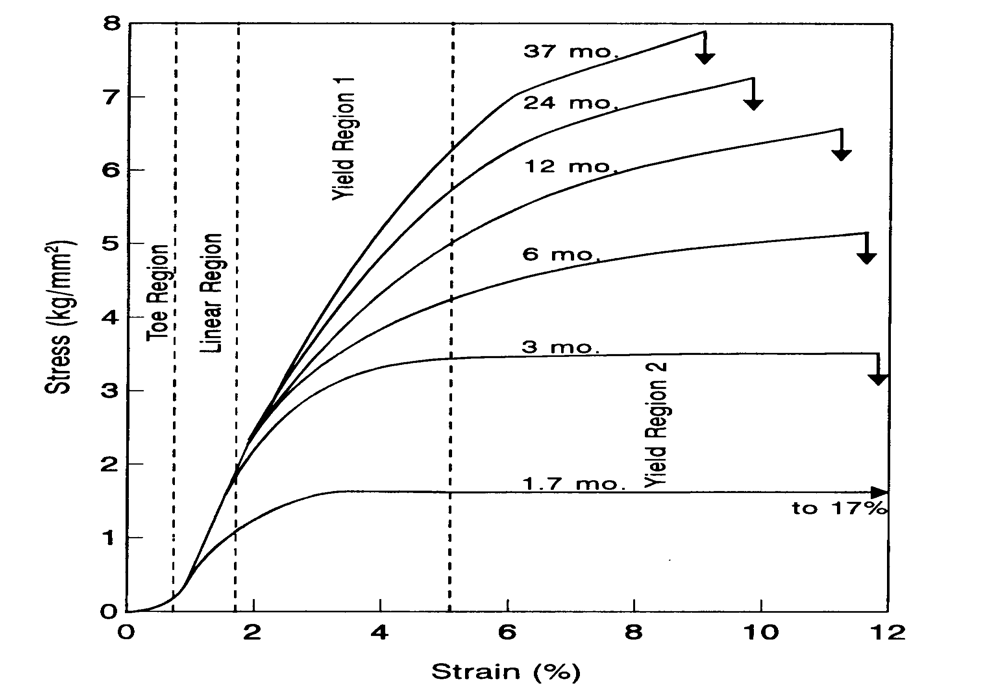Biomechanics Exam 4
1/199
There's no tags or description
Looks like no tags are added yet.
Name | Mastery | Learn | Test | Matching | Spaced |
|---|
No study sessions yet.
200 Terms
Viscosity
resistance to flow; ability to dissipate energy
usually referred to liquids
governed by Newton’s Law
viscosity is caused by…
internal friction
Newton’s Viscosity law
sigma is stress
n is coefficient of viscosity
gamma . = strain rate
constitutive: Double strain rate, double stress

elasticity
the ability to return to its original shape; ability to
usually referred to solids
governed by Hookes law
Hooke’s law
sigma = stress
E = elastic modulus
epsilon = strain
constitutive: Double strain, double stress

ELASTIC deformation is effectively….
INSTANTANEOUS
total deformation occurs the INSTANT stress is applied, and completely disappears the instant it is released
viscous behavior
deformation is not instantaneous
deformation delayed in response to stress (NOT fully reversible or completely recovered)
viscoelasticity
combination of viscous and elastic properties
posses FLUID and SOLID properties
viscoelastic models
springs and dashpots
connected in various forms
for a viscoelastic material, at CONSTANT STRESS…
STRAIN INCREASES with TIME (creep)
for a viscoelastic material, AT CONSTANT STRAIN…
STRESS DECREASES WITH TIME (relaxation)
for a viscoelastic material, the EFFECTICE STRESS DEPENDS ON…
the RATE of APPLICATION OF LOAD
fast, little to no deformation
slow, higher deformation
for a viscoelastic material, if CYCLIC LOADING is applied…
there is a PHASE LAG between the APPLIED STRESS and RESULTING STRAIN
there is a corresponding DISSIPATION of MECHANICAL ENERGY (hysteresis)
for a viscoelastic material, ACOUSTIC WAVES experience
ATTENUATION (reduction of amplitude)
for a viscoelastic material, REBOUND of an object following an impact is…
LESS THAN 100%
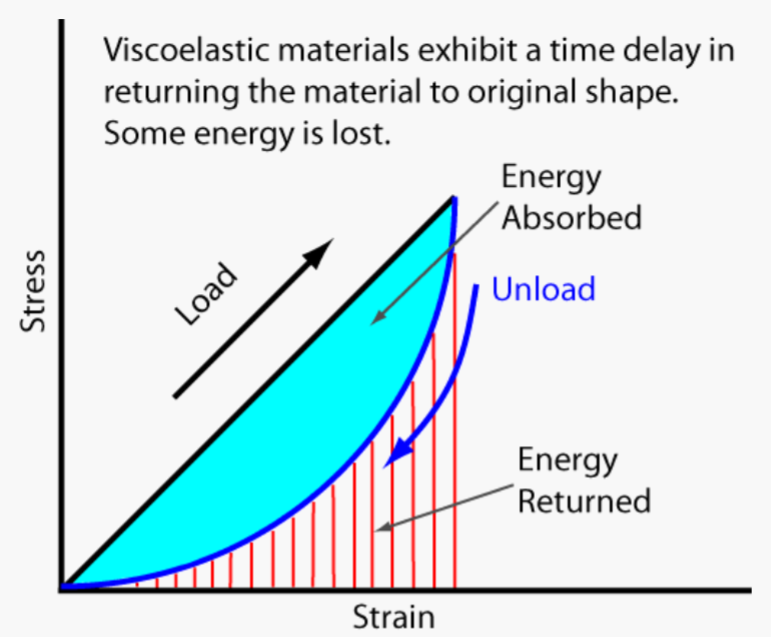
This figure describes what viscoelastic phenomenon?
Hysteresis = AREA BETWEEN loading and unloading curve
dissipation of energy
loading portion MUST be HIGHER than unloading curve

This figure describes what viscoelastic phenomenon?
RATE DEPENDENCY
creep
SLOW, PROGRESSIVE deformation of a material under constant stress
Creep Compliance
in linearly viscoelastic materials, this is INDEPENDENT of Stress level

in viscoelastic materials, if load is released at a later time…
the strain WILL EXHIBIT RECOVERY
AKA Progressive decrease of deformation
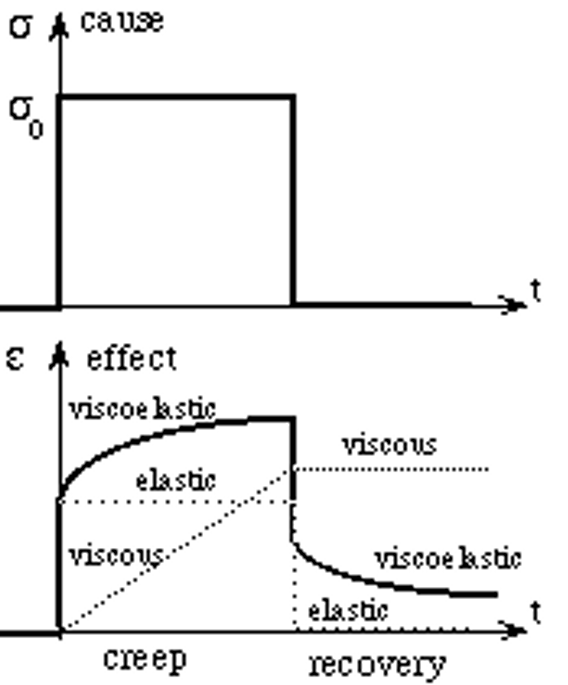
this figure best shows which viscoelastic phenomenon?
Creep and Recovery
stress relaxation
the gradual DECREASE of STRESS when the material is held at CONSTANT STRAIN
relaxation modulus
in linear materials, INDEPENDENT of STRAIN level

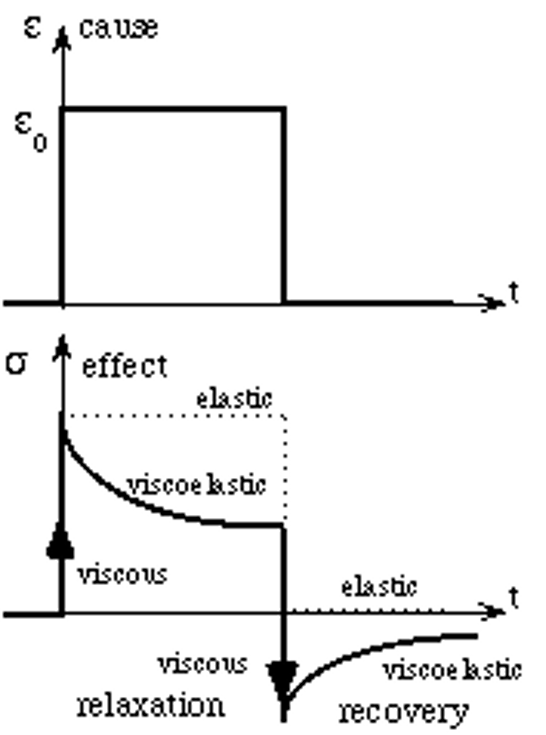
this figure best shows which viscoelastic phenomenon?
stress relaxation and recovery
sinusoidal oscillation applied stress waveform
sigma = stress
sigma 0 = stress amplitude
omega = 2*pi*f or angular frequency
t = time

sinusoidal oscillation applied strain waveform
gamma = strain
gamma 0 = strain amplitude
omega = 2*pi*f or angular frequency
t = time
delta = PHASE LAG (loss angle)


this figure best shows which viscoelastic phenomenon?
sinusoidal wave forms for stress and strain functions
the phase lag and amplitude ratio (sigma 0/gamma0) vary with….
FREQUENCY
considered material properties under LINEAR VISCOELASTIC CONDITIONS
for an ideal solid, the phase lag (delta) angle is…
0 degrees
response is purely ELASTIC
for a NEWTONIAN FLUID, the phase lag (delta) angle is…
90 degrees
yields a purely VISCOUS response
mechanical testing of viscoelastic materials
machine applies a SINUOSIDAL LOAD to specimen
measures load (stress) and position (strain) as functions of time (phase angle, delta)
the “as measured” stress is the COMPLEX STRESS (0<delta<90)
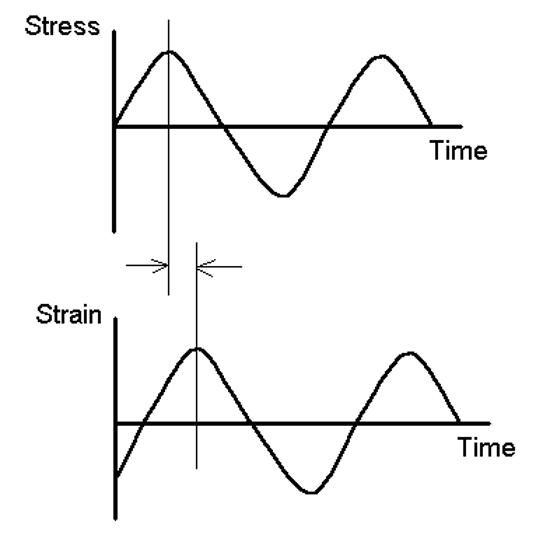
this figure represents what for a viscoelastic material?
Phase Angle (Delta)
0<delta<90 degrees
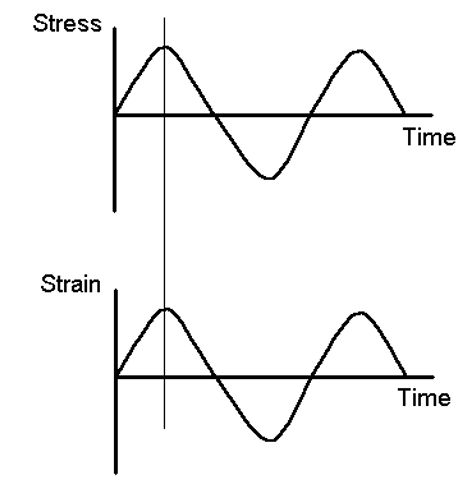
this phase angle diagram represents what kind of material and phase angle value?
a purely ELASTIC material
delta = 0
(Hookean Solid)
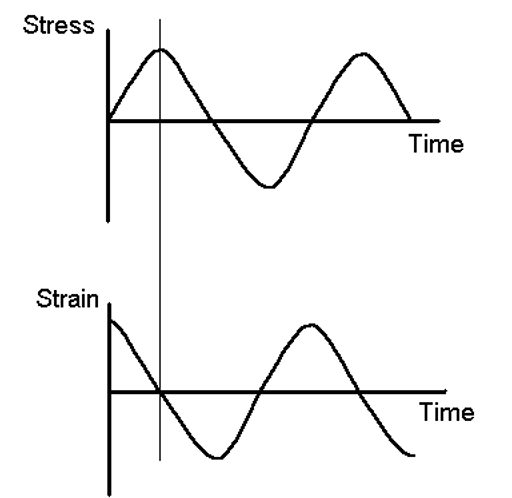
this phase angle diagram represents what kind of material and phase angle value?
a purely VISCOUS material
delta = 90
(Newtonian Liquid)
storage modulus
G’
represents the IN PHASE (ELASTIC) component
equation of storage modulus
sigma 0 = stress amplitude
gamma 0 = strain amplitude
delta = phase angle
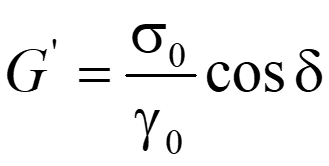
loss modulus
G”
represents the OUT OF PHASE (VISCOUS) component
indicated capacity to DISSIPATE energy as heat
equation of loss modulus
sigma 0 = stress amplitude
gamma 0 = strain amplitude
delta = phase angle
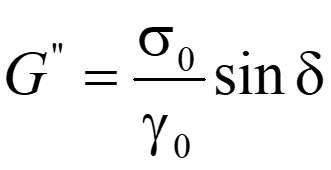
complex shear modulus
G*
represents the overall resistance to deformation
equation of complex modulus
G’ = storage modulus
G” = loss modulus
j = square root(-1)
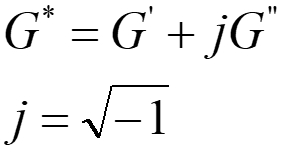
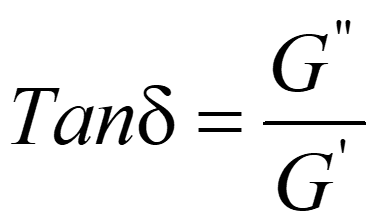
tan(delta) = G”/G’
is a measure of material dampening
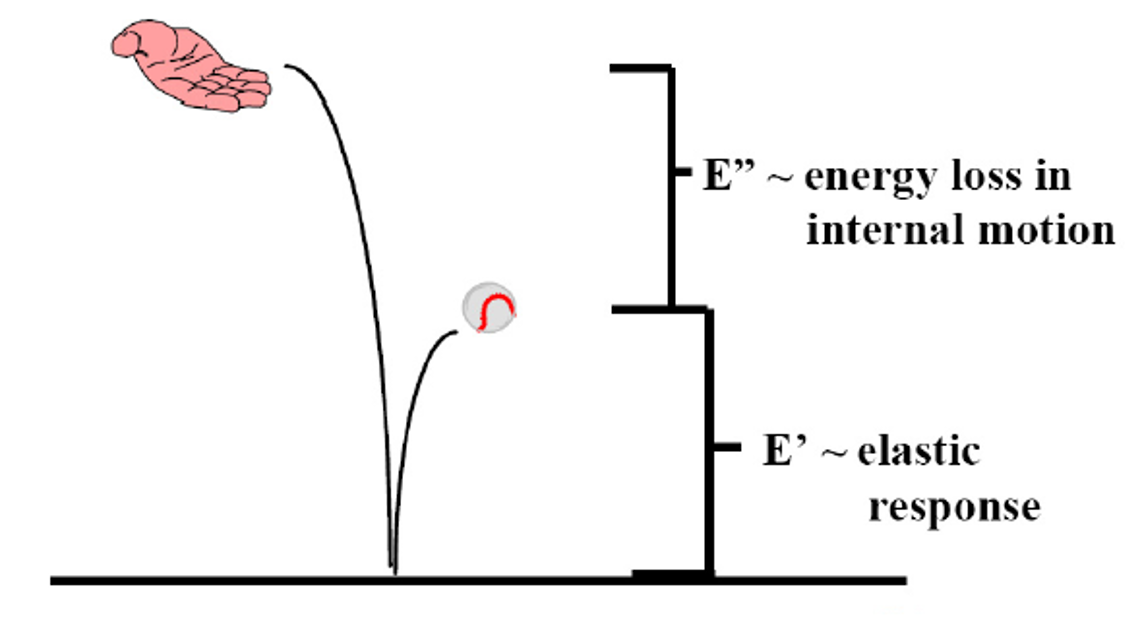
this diagram represents what?
the energy loss (loss modulus) in internal motion and the elastic response (storage modulus)
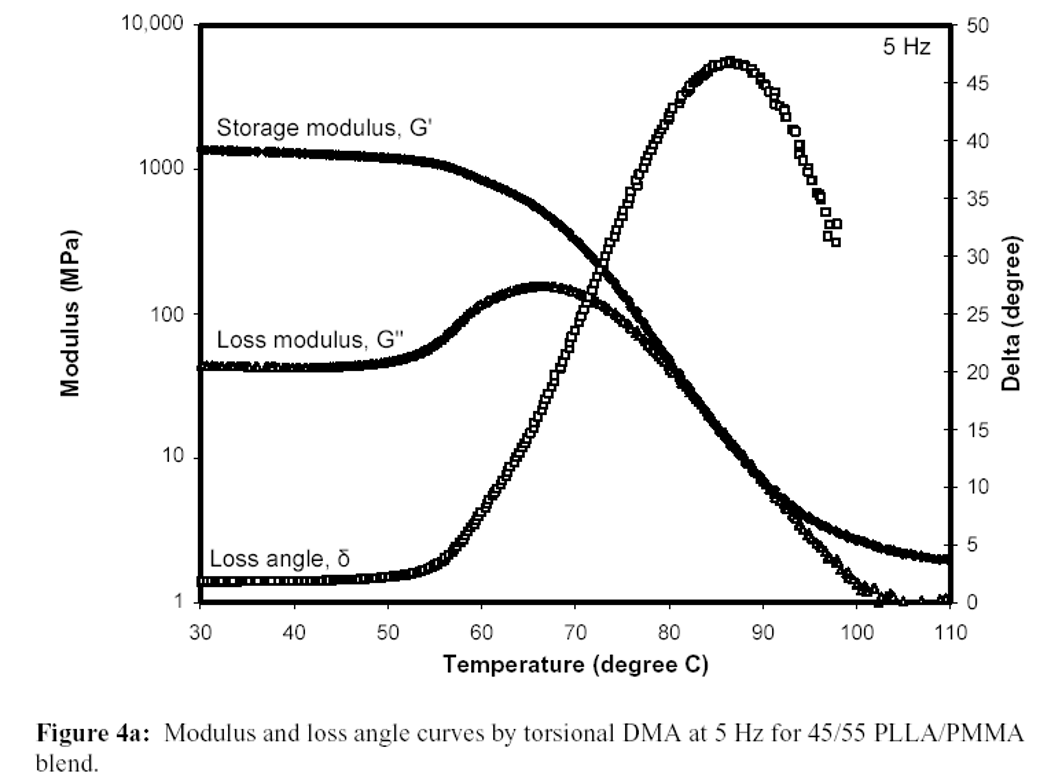
What can be determined from this diagram?
Storage modulus and Loss modulus are HIGH at LOW temperatures, while phase angle is LOW at LOW temperatures
As a material is heated, storage modulus and loss modulus DECREASE, while phase angle INCREASE
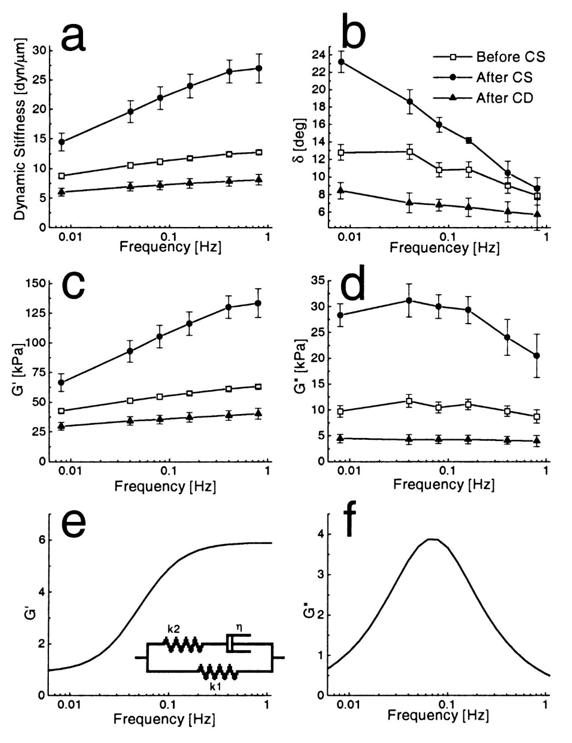
from this graph, it can be concluded that…
Dynamic stiffness and Storage modulus INCREASE WITH FREQUENCY
Phase angle and Loss modulus DECREASE WITH FREQUENCY
Everything is sensitive to frequency
what are the 3 spring and dashpot models?
Maxwell Model
Kelvin-Voight Model
Standard Solid Model
Maxwell Model
spring and dashpots in SERIES
represents a FLUID since it relaxes completely to 0 stress and undergoes CREEP INDEFINITELY
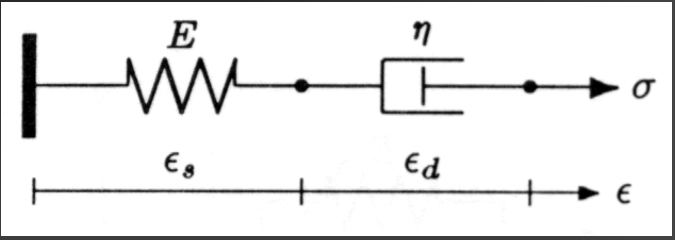
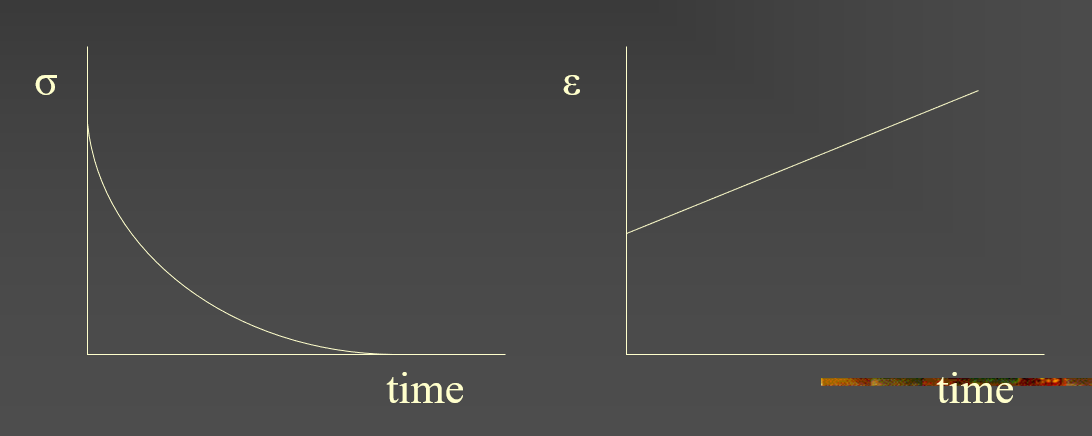
These graphs represent which spring and dashpot model?
Maxwell Model
Standard Solid Model
a three parameter model used to describe VISCOELASTIC behavior of biological materials
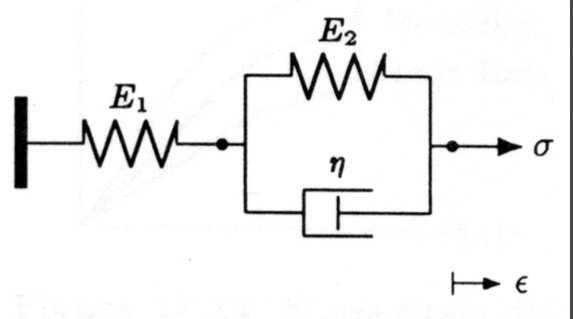
Kelvin Voight Model
spring and dashpots in PARALLEL
dashpot does NOT allow INSTANTANEOUS deformation to occur, but overtime, the DISPLACEMENT creeps to an ASYMPTOTIC level

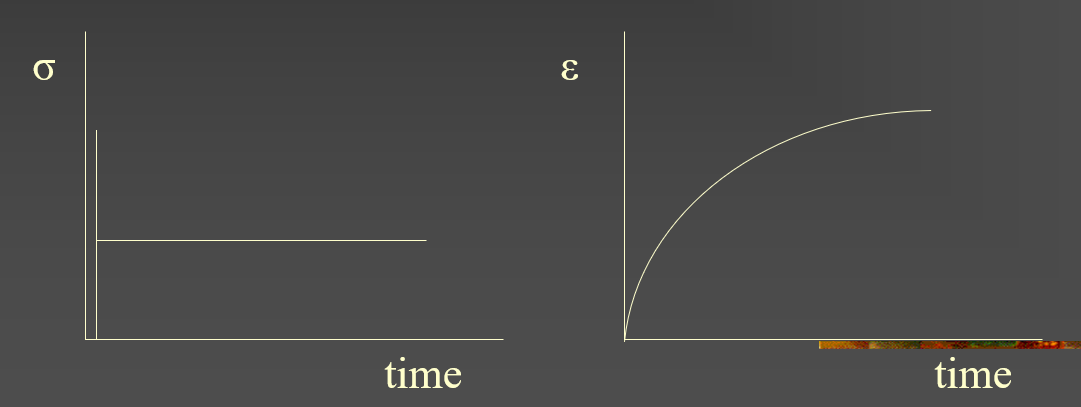
These graphs represent which spring and dashpot model?
Kelvin-Voight Model
ligaments connect…
BONE TO BONE
tendons connect…
BONE TO MUSCLE
both tendons and ligaments are composed of…
Closely packed, PARALLEL COLLAGEN FIBER BUNDLES
Type 1 collagen is how much percent of tendon and ligament dry weight?
70-80%
What is collagen embedded in?
Ground substance of proteoglycans (PGs), glycolipids, and water
water and PGs provide LUBRICATION and SPACING for gliding function at intercept points where fibers CROSS in tissue matrix
the functions of LIGAMENTS
augment mechanical stability of joints
guide joint motion
prevent excessive motion
the functions of TENDONS
attach bone to muscle
transmit tensile loads from muscle to bone
in addition to collagen, ligaments may contain a small amount of…
ELASTIN
structure and chemical composition of ligaments and tendons is…
HIGHLY CONSERVED among species
collagen is synthesized by…
fibroblasts
1st as larger precursor (procollagen), then secreted and cleaved to become collagen
collagen molecular structure
3 helical, about 1000 amino acid polypeptide chains
2 alpha-1 chains
1 alpha-2 chain
the molecular weight of collagen is?
340 kDa
the collagen chains are combined in
a Right-handed triple helix
gives rod-like shape
280 nm LENGTH
1.5 nm DIAMETER

This diagram represents
the structure of collagen
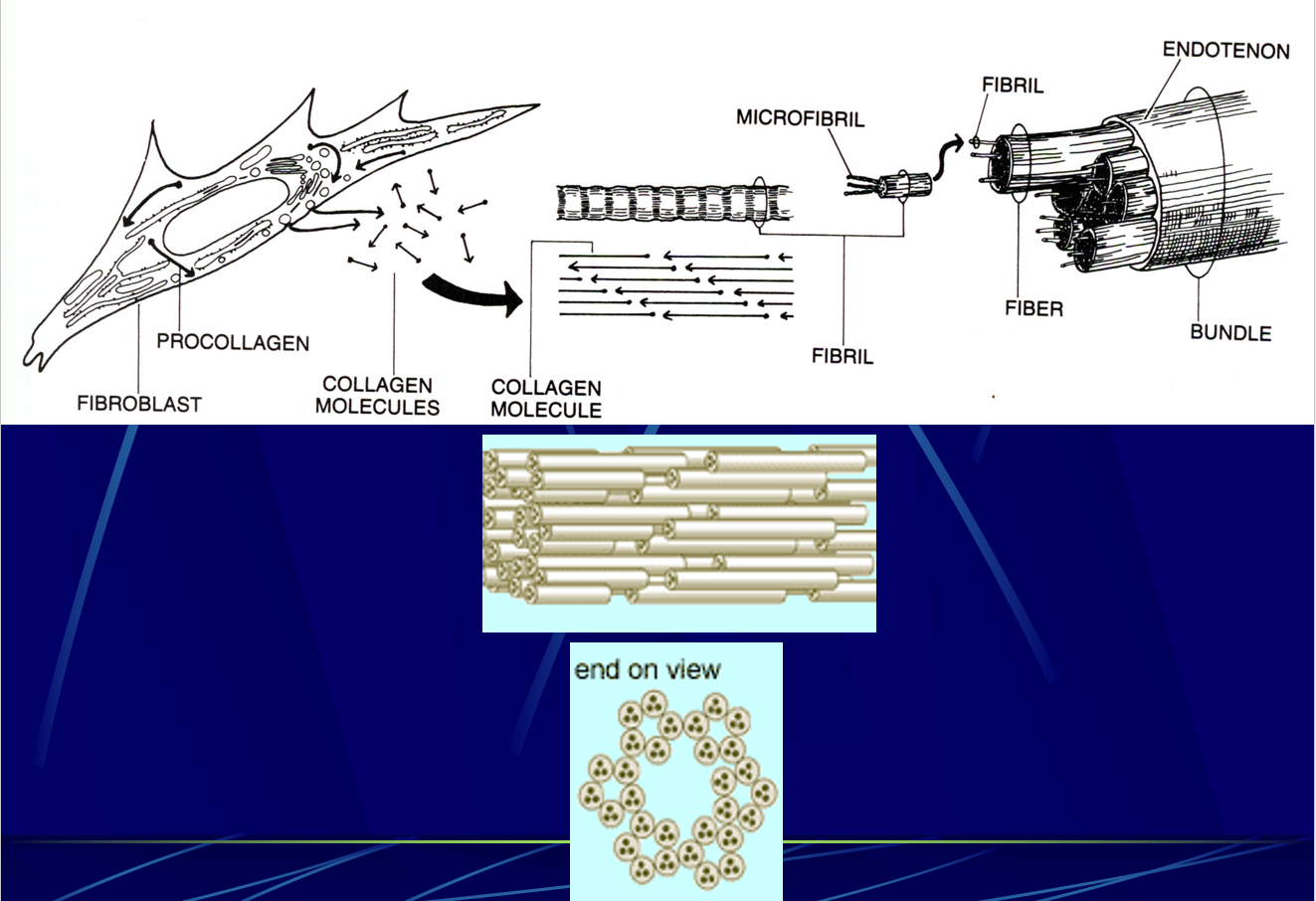
these diagram represent
the hierarchy and components of collagen as well as view points
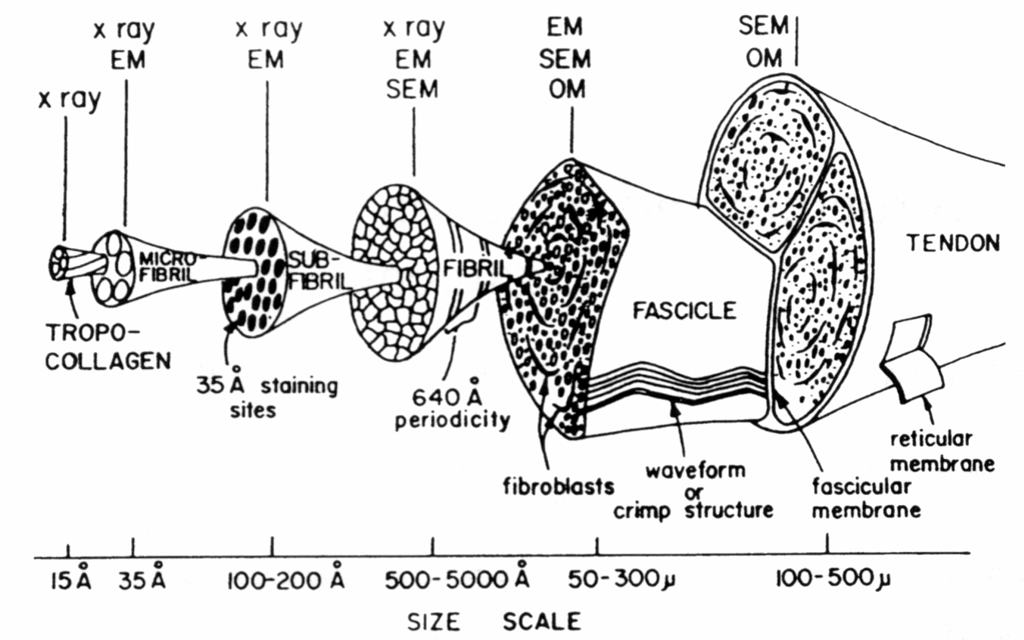
the diagram shows
the tendon hierarchy
tropocollagen<microfibril<sub-fibril<fibril<fascicle<tendon
percentages of collagen
2/3 Glycine (33%)
Proline (15%)
Hydroxyproline (15%)
every THIRD amino acid in each alpha chain of collagen is…
GLYCINE
small size allows tight helical packing of molecule
glycine
amino acid that is 33% of collagen
small, allows for tight helical packing of molecule
enhances stability by forming HYDROGEN BONDS among the three chains of collagen
interchain crosslinks
hydrogen bonds with glycine among the three chains
essential to aggregation of the collagen molecules at the FIBRIL level
intrachain crosslinks
proline and hydroxyproline form hydrogen bonds within each chain
collagen fibril
formed by aggregation of several collagen molecules in a quaternary structure, in which molecules overlap
causes BANDING pattern
collagen fibers
further aggregation of collagen fibrils which are visible under light microscope
1-20 micrometer diameter, many cm long
fibroblasts are aligned in ROWS..
BETWEEN FIBER BUNDLES
the fibroblast cells are…
elongated along an axis in the direction of l
collagen fibers of tendons
More orderly with PARALLEL orientation
collagen fibers of ligaments
Less orderly without parallel orientation
the half-life of collagen
Very LONG
same collagen molecule can exist throughout an entire life
ground substance
mixture of water and organic molecules
highly HYDROPHILLIC
contributes to:
diffusion of metabolites
spacing between fibers
strength and elasticity
ground substance consists of
Glycoproteins: adhesive between cells and cells to collagen
Proteoglycans: proteins (5%) and GAG chains (95%) covalently linked → binds Water
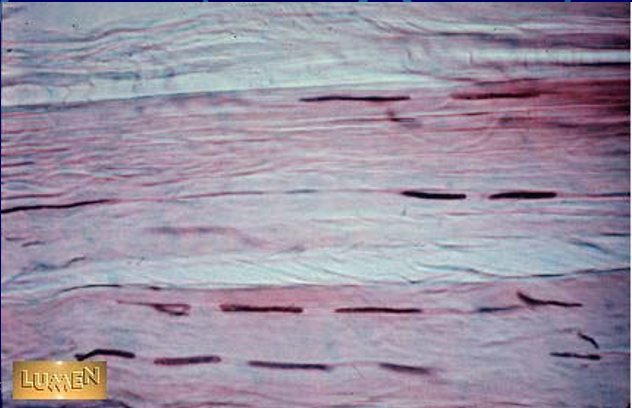
This figure describes what?
a tendon cut LONGITUDINALLY
collagen fibers = pink, lined parallel to each other in response to stress
fibroblasts = black lines displaying stretched nuclei
squeezed between fibers and line up in parallel rows
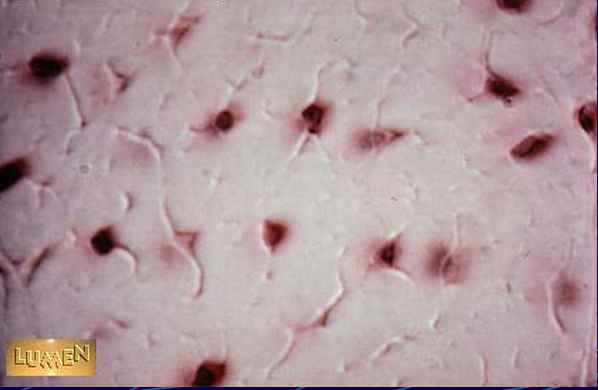
this figure describes what?
a tendon cut in CROSS SECTION
pale pink background = cut ends of bundles of thick collagen fibers
wispy lines/”cracks" = place where fibroblasts are
triangular or stellate due to being squeezed between fibers
similarities between ligaments and tendons
fibroblasts surrounded by GROUND SUBSTANCE and fibers
fibers primarily TYPE 1 AND 2
PGs important for organizing ECM
chondroitin and keratan sulfate exert swelling pressure
dermatan sulfate affects ECM and fibril formation
Insertional Morphology
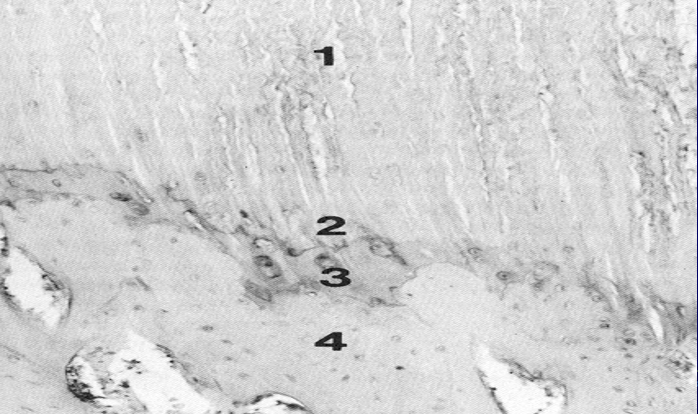
this diagram shows what?
INSERTIONAL MORPHOLOGY of LIGAMENTS AND TENDONS
is collagen fibers
is unmineralized fibrocartilage
is mineralized fibrocartilage
is cortical bone
tendon and ligament insertions to bone are functionally adapted to…
distribute and dissipate the forces they carry by passing through fibrocartilage to bone
characteristics of ligaments ONLY
MORE TYPE 2 collagen (and elastin)
LESS perfectly aligned fiber orientation
MORE GAGs and water
MORE cells and metabolically active
characteristics of tendons ONLY
THINNER collagen fibrils
MORE parallel fiber arrangement
structural hierarchy: FASICLES
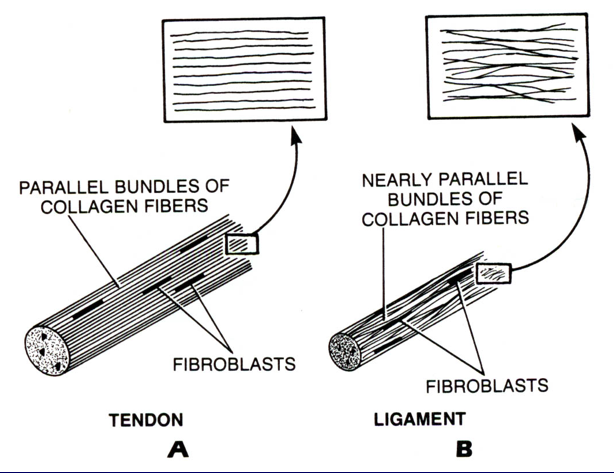
this diagram shows
the differences between the FIBER ORIENTATION of tendons and ligaments
tendons: MORE PARALLEL BUNDLES
ligaments: not as parallel bundles of collagen
paratenon
loose membrane that surrounds TENDONS, forms sheath that protects the tendon and enhances gliding
epitenon
synovium-like membrane that may exist beneath the paratenon where friction forces are very high
the cells in this produce synovial fluid that facilitates gliding of the tendon
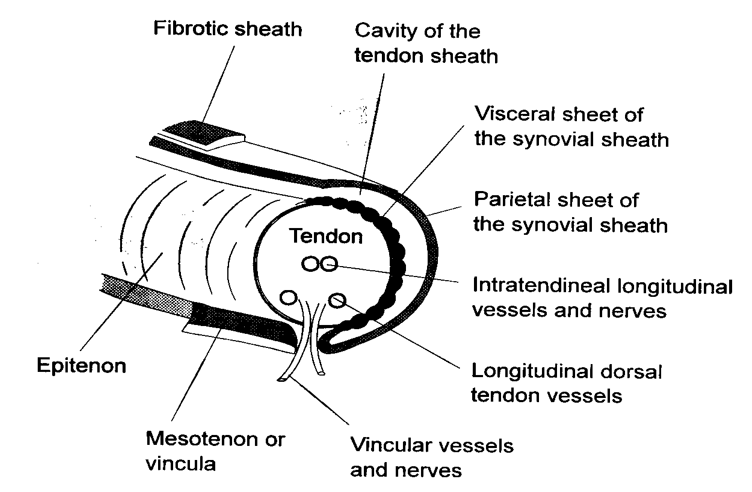
this diagram represents?
the tendon sheath
contains the paratenon and epitenon
tendon/ligament tensile test
exist in toe region and somewhat in linear region
toe-in region = “uncrimping” of collagen fibrils → backbone is stretched making it STIFF (linear region)
when failure of fibrils start: damage accumulates, and stiffness is REDUCED causing ligaments/tendons to fail

tendon mechanical properties
Tensile Strength: 50-150 MPa
Elastic Modulus: 1.2-1.8 GPa
True or False: Ligaments are LESS strong and stiff than tendons
TRUE
they have LOWER COLLAGEN CONTENT
MORE woven collagen structure compared to tendon’s parallel arrangement
Viscoelastic characteristics
Creep
Stress-Relaxation
Hysteresis
ligaments and tendons are what kind of materials?
viscoelastic
rate dependent functions have…
Increased stiffness with Increased loading rate
stores MORE potential energy
requires MORE force to rupture
hysteresis
if a viscoelastic material is loaded and unloaded, the unloading curve will NOT follow the loading curve
the difference between the two represents the amount of energy that is dissipated during loading
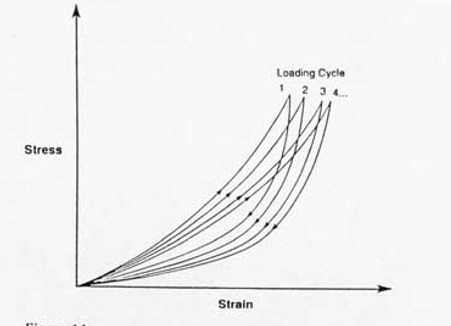
tendons and ligaments are
rate dependent and age dependent functions
age dependent functions
stronger with age
stiffer with age
less strain required for rupture
